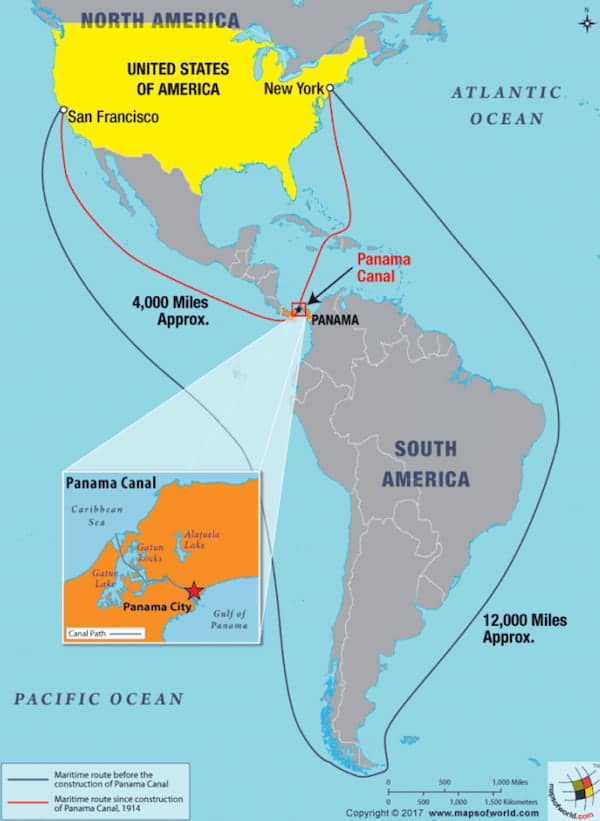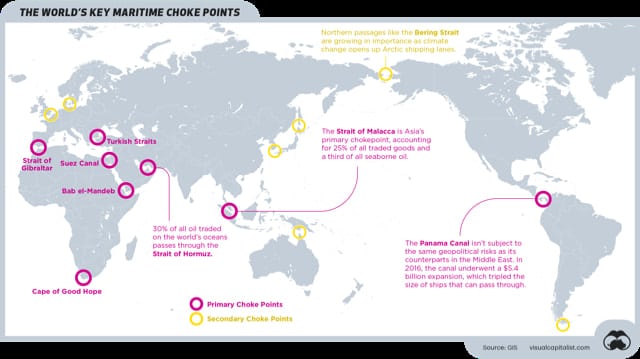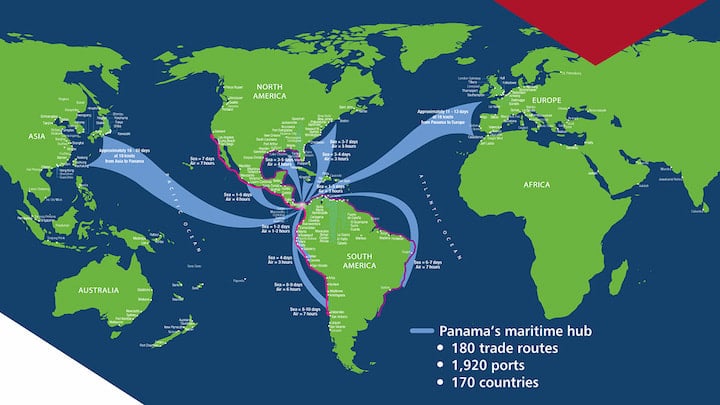Alternatives to the Panama Canal could provide countries with geopolitical “soft power”. The only recent alternative, Mexico’s CIIT, can however only relieve 5–10% of maritime freight. Therefore, the canal remains a critical nexus for a.o. the U.S. Navy. This is the fourth of five posts on global freight chokepoints.
The Panama Canal is a Geopolitical Achilles’ Heel for the U.S.
Today, the Panama Canal is the only viable route for maritime freight and naval movement between the eastern and western coastsof South and North America. To the north, ice blocks navigation for most of the year. To the south, the Magellan and Drake Straits make for perilous sailing and add 11,000 kilometers to the journey.
A Commercial Success Since Its Inception ...
Commercially, Panama has been an almost uninterrupted success from the start. Each year, nearly 15,000 ships transit the Panama Canal, carrying around 500 million tons of cargo valued at approximately USD 270 billion.
Since its opening in 1914, the canal has been a success and has been expanded several times, most recently in 2016. Today, it can accommodate ships carrying between 13,000 and 14,000 containers (Neo-Panamax size). Transit fees range from USD 0.5 million to over USD 1.0 million.
… But Strategic Limitations Are Growing, Worsened by Climate Change
Strategically, however, the canal has significant limitations.
First, demand for freight transport is rising, and expanding the canal’s lock capacity is becoming increasingly expensive.
Second, climate change is causing more frequent droughts that lower water levels in Lake Gatun, which ships must cross. During drought periods in 2023 and 2024, for example, the number of transits was halved. This particularly affected tankers, many of which had to navigate around South America instead. Canal authorities must prioritize building dams before they can invest in expanding lock capacity.
As a result, it has become financially attractive for many Central American countries to establish an alternative. Panama itself also recognizes the realistic limitations of the canal.
Historically, the U.S. Has Considered Alternatives Many Times
Before the United States took over the completion of the Panama Canal from a French consortium in 1904, Congress considered two other alternatives: Nicaragua and Mexico.
The first, Nicaragua, was initially the favorite because the country already had natural waterways (including Lake Nicaragua and the San Juan River) that could be adapted. This could have made the project cheaper and, more importantly, provided greater capacity than Panama. However, concerns about eruptions from a nearby volcano stopped the U.S., as Congress at the time concluded there was no foreseeable need for such high capacity.
The Mexico Canal was at times a strategic favorite. However, increasing social unrest shelved the plan. The Mexican Revolution ultimately broke out in 1910.
A Canal Through Nicaragua Was Initially the Preferred Option
The concerns about volcanic eruptions turned out to be greatly exaggerated. As a result, the canal through Lake Nicaragua has been reconsidered multiple times by the U.S., including in the 1960s. However, U.S. political relations with Nicaragua have fluctuated greatly.
In 2012, a relatively unknown Chinese businessman, Wang Jing, signed a construction agreement with Nicaragua for a project valued at USD 50 billion. The canal would have been 270 km long. While it was assumed the Chinese government backed the project, this was never confirmed.
Construction began in 2014, but by 2015, public protests grew increasingly intense, including from environmental organizations. The project would have devastated Lake Nicaragua, the country’s critical source of freshwater supply.
This plan was briefly revived in 2014, …
At the same time, Wang Jing lost most of his fortune during the Chinese market turmoil of 2015/16. This halted funding, and the Chinese government chose not to take over the project. As a result, the entire initiative came to a standstill. However, the Nicaraguan government did not officially abandon the project until 2024.
Today, the government is exploring other possibilities for a canal under the Grand Canal Authority. The prospects, however, remain modest, as relations between Nicaragua and the U.S. remain strained and face diplomatic challenges. This is a poor starting point for attracting funding, especially since 72% of the freight in question (currently passing through Panama) is to or from U.S. ports.
… And Could Resolve the U.S. Maritime Bottleneck
If Nicaragua were to build a canal, it could offer greater freight capacity than the Panama Canal. This would have a transformative effect on the economies of Central America. Additionally, it would enhance U.S. security by ensuring its fleets could pass freely between the Atlantic and Pacific, regardless of droughts in Lake Gatun.
However, based on historical precedent, the U.S. would likely demand ownership of the canal, as was the case in Panama until 1977 (under the Torrijos-Carter Treaties). In practice, this would require control over Nicaraguan land. Beyond public resistance, Nicaragua’s constitution explicitly forbids this (e.g., Articles 3 and 102).
Mexico Has Recently Opened a Relieving Freight Corridor ...
As early as 1907, Mexico opened a railway line from Oaxaca on the Pacific coast to Veracruz on the Gulf of Mexico. The railway was a major success until the Panama Canal opened seven years later. Freight volumes then dropped to a fifth, and the railway gradually fell into disrepair.
In 2018, President López Obrador (AMLO) relaunched the project with three railway lines: one from Salina Cruz on the Pacific to Coatzacoalcos, and two branches to Hidalgo and Palenque, forming a comprehensive logistics plan. In 2020, the project began with vegetation clearance and the construction of 1,000 km of new tracks.
… Providing Supply Chain Security
In August 2023, AMLO inaugurated the first section of the route, called “The Interoceanic Corridor of the Isthmus of Tehuantepec" (CIIT). The transit time, including the loading and unloading of railcars and container ships, is just 3–9 hours longer than the 12 hours it takes, at best, to pass through the Panama Canal. This creates direct competition for shipping to and from U.S. ports. By 2025, the project is expected to be about 90% complete, including the development of deepwater ports.
However, the corridor can only handle 5–10% of the Panama Canal’s activity. CIIT is therefore primarily a critical redundant freight route to relieve pressure on Panama. The droughts in Lake Gatun during 2023 and 2024 have demonstrated the enormous supply chain value of such a backup. As a result, CIIT has gained significant geopolitical value for Mexico. Additionally, Mexico expects transit revenues, including associated economic activities, to boost the country’s GDP by 3.5% annually.
Only a Nicaraguan Canal Can However Address this U.S. Naval Achilles’ Heel
Strategically, CIIT can provide some relief for commercial freight between the U.S. and Mexico. However, in terms of national security, there is no alternative to the Panama Canal for the U.S. Navy. Thus, Panama remains a critical vulnerability for U.S. security policy, just as it was in the 1890s when the U.S. first explored passage options in Central America.
A project through Nicaragua would depend on the U.S.’s willingness to fund and use the canal. This would fundamentally require improved relations between the two countries.
See the previous three posts and the next blog entry in this series for further context.





